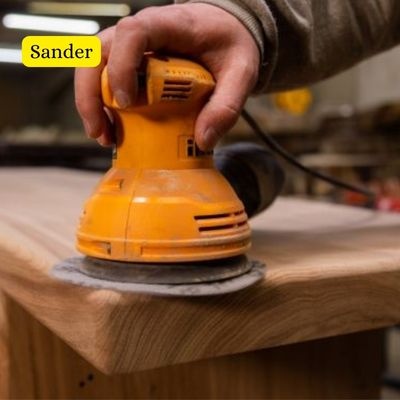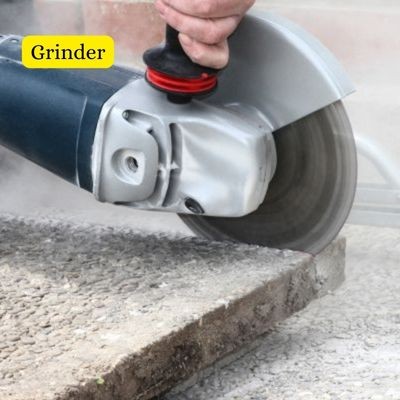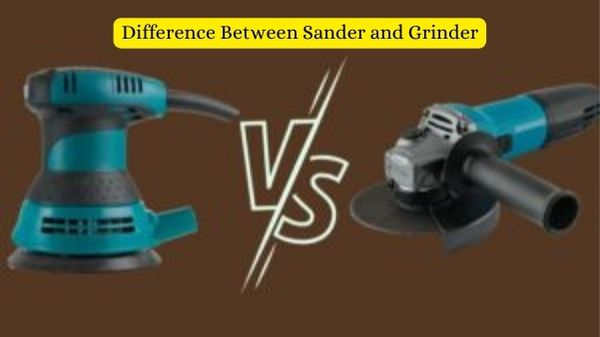Do you know the difference between sander and grinder? Many people are confused about the difference between these two types of power tools. In this blog post, we will discuss the difference between Sander and Grinder. We will also provide tips on which tool is best for your project.
Sander:

Sander is a tool used to smooth surfaces by abrading them with sandpaper. Sanders come in a variety of shapes and sizes, and can be powered by electricity, compressed air, or batteries.
Sanders are a versatile tool that can be used for a variety of tasks, from sanding down rough surfaces to polishing smooth ones. Whether you are working on a woodworking project or trying to spruce up some old furniture, a sander can help you get the job done quickly and easily.
The sandpaper on sander consists of sharp, abrasive particles that are glued to a paper or cloth backing. Sander is used to remove paint, varnish, rust, and other materials from surfaces. It can also be used to polish surfaces and create a smooth finish. Sanders are available in different sizes, grits, and grades. The size of the sander will determine the size of the area that it can cover. The grit is the number of abrasive particles per square inch. The higher the grit, the finer the sandpaper.
There are different types of sanders available, each designed for a specific purpose.
Hand-held sander: The most common type of sander is the hand-held sander. These are small, lightweight, and easy to use. They are ideal for small projects or areas that are difficult to reach with larger sanders.
Orbital sander: Another type of sander is the orbital sander. This type of sander moves in a circular motion and is used for larger projects. It is more powerful than a hand-held sander and can remove material more quickly.
Working Mechanism of Sander:
The working mechanism of a sander is pretty simple. The sandpaper is attached to the sander. The sander moves the sandpaper back and forth or in a circular motion across the surface of the object. As the sandpaper rubs against the object, it removes material from the surface.
Sanders work by using an abrasive action to smooth out surfaces. The sandpaper is attached to a backing, usually made of cloth or paper, and the user rubs the object to be smoothed with the sandpaper. The abrasive action of the sandpaper removes material from the object, leaving a smooth surface.
How You choose a sander for your project:
When choosing a sander, it is important to consider the type of finish you are looking for. If you need a very smooth finish, then an orbital sander may be your best option. If you are working with wood, then a belt sander may be a better choice. Belt sanders are also available in different sizes and power levels. Smaller belt sanders are good for light duty tasks such as removing paint from wood furniture. Larger belt sanders are more powerful and can be used for heavier duty tasks such as shaping wood or removing varnish.
Grinder:

A grinder is a tool that uses an abrasive wheel to cut, grind, or polish metal. The grinding wheel is usually made of aluminum oxide or silicon carbide. Grinders are also classified according to the power source they use: electric, pneumatic, or hydraulic.
Grinders are used in a variety of industries, including construction, fabrication, and manufacturing. They are also commonly used in auto body shops and machine shops.
Grinding machines are used for a variety of different applications. Some common examples include removing rust from metal objects, shaping stone or concrete, and finishing wood surfaces. Grinders can also be used to create a smooth finish on glass or plastic objects. Abrasive wheels can be made from a variety of materials, including aluminum oxide, silicon carbide, or diamond. The type of wheel you use will depend on the material you are grinding and the desired finish.
- Aluminium oxide wheels are good for general purpose grinding on metal objects.
- Silicon carbide wheels are more aggressive and can be used for grinding non-metallic materials such as stone or concrete.
- Diamond wheels are the most expensive but are able to cut through hard materials such as ceramic or glass.
There are three main types of grinders:
Surface Grinders: Surface grinders are used to create a smooth finish on flat surfaces. Surface grinders use a rotating abrasive wheel to remove material from the surface of a workpiece. The speed of the wheel and the pressure exerted on the workpiece determine the rate at which material is removed. Surface grinders can be either wet or dry. Wet surface grinders use coolant to keep the workpiece from overheating.
Cylindrical Grinders: Cylindrical grinders are used to shape the outside of an object. The workpiece is held in place by a chuck and rotated while an abrasive wheel removes material from the surface. You can either buy a wet cylindrical grinder or a dry cylindrical grinder. Wet cylindrical grinders use coolant to prevent overheating of the workpiece.
Bench Grinders: Bench grinders are designed for sharpening tools or removing rust from metal objects. Two abrasive wheels are mounted on a shaft that is rotated at a high speed. The distance between the two wheels can be adjusted to control the fineness of the grind. Bench grinders are usually dry.
Working mechanism of grinder:
The working principle of a grinding machine is quite simple. The grinder consists of an abrasive wheel, a work table, and a support table. The abrasive wheel is made up of small particles of hard material such as diamonds, carborundum, or silicon carbide. The work table is held in place by a chuck that holds the workpiece to be ground.
The support table is used to keep the workpiece from vibrating during grinding. The abrasive wheel is rotated at a high speed and brought into contact with the workpiece. The force of the spinning wheel removes material from the surface of the workpiece.
How You choose a grinder for your project:
The most important thing to consider when choosing a grinder is to make sure that the grinder you choose is appropriate for the material you will be working with and the finish that you desire. In terms of size and power level, grinders are available in a wide range of sizes. Generally speaking, smaller grinders are better suited for light-duty tasks such as sharpening tools or removing rust from metal objects. The larger grinders are more powerful, and they can be used for heavier duty tasks, such as shaping stone or concrete, which require more power.
Difference between Sander and Grinder:
While both sanders and grinders are tools that can be used to smooth surfaces, there are some key Difference Between Sander and Grinder. Sanders use abrasive paper or pads to sand down rough edges, while grinders typically use rotating disks to grind away material. Grinders also tend to be more powerful than sanders, making them better suited for tougher jobs.
One important difference to keep in mind is that sanders can be used for both wood and metal, while grinders are typically just for metal. So, if you are working on a project that involves both materials, you will need to use a sander.
When it comes to sanding, Sanders tends to be more gentle and provide a smoother finish. Grinders, on the other hand, are more powerful and can remove more material quickly. But, grinders can also leave behind more scratches and roughness.
So, what’s the best tool for the job? It really depends on what you’re trying to achieve. If you need to remove a lot of material quickly, or if you are dealing with tough surfaces, a grinder is probably your best bet. But if you are just looking to smooth out a few rough edges, a sander will do the trick.
Now that you know the difference between sander and grinder, you can make a more informed decision about which tool is right for your next project.
